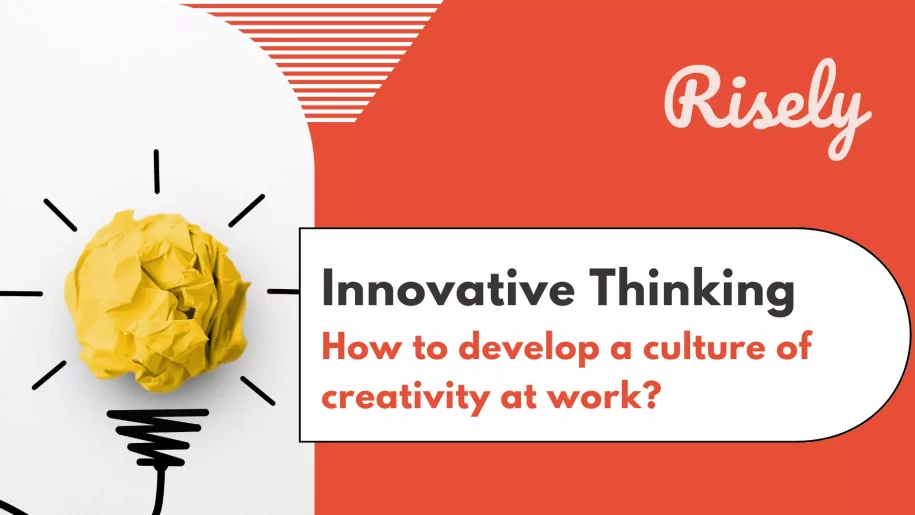How to Develop a Culture of Creativity at Work?
Are you looking for ways to enhance productivity, solve complex problems, and generate new ideas? Look no further than creativity. Creativity is not just for artists and musicians – it is a critical skill that anyone in the workplace can harness. Moreover, fostering creativity at work can lead to improved productivity, innovation, and business success. But how exactly can you tap into your creativity at work? In this blog, we’ll explore the importance of creativity in the workplace and provide practical tips and examples for how you can unleash your creative potential and positively impact your work and your team. Whether you work in a creative industry or not, creativity is a valuable asset that can help you stand out from the crowd and achieve your goals.What does being creative at work mean?
Creativity means using your imagination and originality to generate new ideas, approaches, and solutions to problems. It involves thinking outside the box, challenging assumptions, and taking risks. Being creative at work means being willing to experiment, take risks, and push the boundaries of what is considered possible or conventional. It can help employees add value to their roles and contribute to the team’s success. In fact, 60% of CEOs polled by IBM rate creativity among the top most leadership qualities one needs to have!How do employees show creativity at work?
There are many ways that employees can show their creativity at work, including:- Brainstorming new ideas and approaches to solve problems or improve processes.
- Experimenting with new techniques or tools to enhance productivity or improve outcomes.
- Developing new products or services that meet the needs of customers or the company.
- Designing innovative solutions to complex challenges, such as developing new software or improving existing systems.
- Collaborating with colleagues to develop fresh and exciting ideas for projects or initiatives.
Why is it important for employees to be creative at work?
There are several reasons why creativity at work is important for employees. First, creativity can lead to innovation and development of new products, services, and ideas. This can give a company a competitive advantage in the marketplace and help it to stay ahead of its competitors. Secondly, creative employees are often better problem solvers. They can develop unique and effective solutions to problems that might be difficult for others. This can help a company to save time and money by avoiding costly mistakes and improving efficiency. Thirdly, creativity can help to improve employee satisfaction and engagement. When employees feel like they can express their creativity and contribute to the company meaningfully, they are more likely to feel fulfilled and motivated in their work. Fostering a culture of creativity at work can lead to a more productive, innovative, and engaged workforce.You Should Bother About Creativity at Work, Here’s Why
There are many benefits of creativity at work, including:- Increased innovation: Creative employees can develop new ideas and approaches that can lead to the development of innovative products, services, and processes. This can help a company to stay competitive in the marketplace and also increase motivation.
- Improved problem-solving: Creative employees are often better at solving complex problems because they can think outside the box and approach problems from different angles.
- Increased productivity: Creative employees can find new and better ways to complete tasks, which can increase efficiency and productivity in the workplace.
- Enhanced teamwork: Creativity can foster a collaborative and inclusive workplace culture, improving employee teamwork and communication.
- Improved job satisfaction: When employees can express their creativity and contribute to the company meaningfully, they are more likely to feel satisfied and fulfilled in their work.
- Increased employee engagement: Employees encouraged to be creative are more likely to be engaged and committed to their work, leading to lower turnover rates and increased loyalty to the company.
Other Interesting Reads
How can you foster creativity at work?
Managers can foster creativity in several ways, including:- Encouraging open communication: Managers can create an environment where employees feel comfortable sharing their ideas and opinions without fear of criticism or rejection. This can foster a culture of creativity and innovation when approaching problems.
- Resources and support: Managers can provide employees with the resources, tools, and training needed to develop their skills and pursue new ideas. This can include access to technology, training programs, and other resources that can help employees to enhance their creativity.
- Allowing for flexibility and experimentation: Managers can provide employees the time and resources to experiment with new ideas and approaches, even if they may not immediately produce results. This can encourage risk-taking and innovation.
- Recognizing and rewarding creativity: Managers can recognize and reward employees demonstrating creativity and innovation. This can include giving awards or incentives, such as promotions or bonuses, to employees who develop successful new ideas or approaches.
- Setting clear goals and expectations: Managers can set clear goals and expectations for employees that support and encourage creativity. This can include developing a vision for the company that inspires employees to think creatively and work towards common goals.
How can you be creative at work?
There’s no set way, there are as many paths as there are minds. Some things that you can do include:- Developing a new product that meets customers’ needs or fills a market gap requires creativity and innovation.
- Designing a marketing campaign that is visually appealing and engaging to customers requires creative thinking and a unique approach.
- Improving an existing process to make it more efficient or effective requires creative problem-solving skills and a willingness to think outside the box.
- Creating a unique and innovative solution to a complex problem requires creativity and a deep understanding.
- Developing a new business model that disrupts the industry or creates a new market requires creative thinking and a willingness to take risks.
- Finding new and innovative uses for existing technology requires creative thinking and a deep understanding of the technology.
- Developing a new service that meets the needs of customers and provides value to the company requires creativity and innovation.
Conclusion
In conclusion, creativity is a valuable skill that can benefit anyone in the workplace, regardless of their industry or role. By fostering a culture of creativity, teams can drive innovation, increase productivity, and gain a competitive edge. In addition, by providing employees with the resources and support they need to unleash their creative potential, teams can harness the power of creativity to solve complex problems and generate new ideas. Whether you’re a manager looking to inspire your team or an individual contributor seeking to tap into your creative potential, the key is to prioritize creativity and embrace a mindset of curiosity, experimentation, and risk-taking. Doing so can unlock your full potential, achieve your goals, and positively impact your work and your team. So, don’t be afraid to think outside the box and unleash your creativity at work.Unlock creative spirits in the workplace with remarkable communication skills!
Test your readiness to build a creative team with the free communication skill assessment from Risely.
Frequently asked questions
How do you show creativity at work?
You can show creativity by developing innovative solutions to problems, generating new ideas, and taking a unique approach to your work. Some ways to demonstrate creativity at work include brainstorming creative solutions to challenges, taking on new projects, experimenting with new techniques, and incorporating creative elements into your work.
What is creativity in the workplace?
Creativity in the workplace refers to the ability to generate new and innovative ideas and approach problems and challenges uniquely.
Why is creativity important in work?
Creativity is important in work because it helps individuals and teams to stay competitive and innovative in a rapidly changing business environment. It can lead to improved problem-solving and productivity and help individuals stand out from the crowd and advance in their careers.
What is an example of creativity at work?
The marketing team develops a unique and engaging social media campaign that stands out from competitors and resonates with customers.
Other Related Blogs
Effective Leadership: An Essential Guide with 10 Tips
Effective Leadership: An Essential Guide with 10 Tips In the ever-evolving tapestry of the corporate world, effective leadership is the linchpin that transforms teams into forces of innovation and achievement.…
5 Proven Ways Managers can Build Collaboration in a Team
5 Proven Ways Managers can Build Collaboration in a Team In today’s fast-paced world, team collaboration is the key to success. But, not all workplaces are conducive to collaborative teams.…
The Top 10 characteristics to look for in Internal Champions
The Top 10 characteristics to look for in Internal Champions In every successful team, there’s a secret ingredient that drives success and propels the team forward. It’s the internal champion…
Creative Problem-Solving Approach: Skills, Framework, 3 Real-life Examples
Creative Problem-Solving Approach: Skills, Framework, 3 Real-life Examples You ever stare at a problem like it’s a brick wall, completely stumped for a solution? You brainstorm every idea you can…


